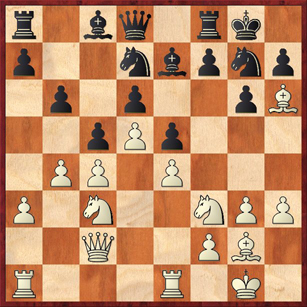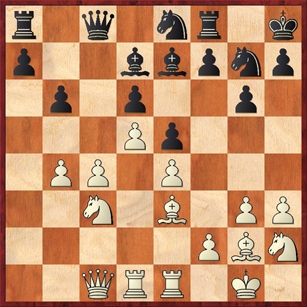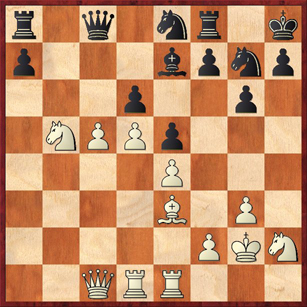I was just playing over one of David Vigorito’s games in the recently concluded Foxwoods Open, and darned if he didn’t pull out the Hook and Ladder Trick! That makes him the second ChessLecturer I know of to make use of it. (The first one was Jesse Kraai, who used it to score a crucial point when he made a crucial point for his second GM norm. See my Chess Life article for further details.)
I’ll place a link to the whole game below, so that you can play it through yourself. Here is the key position. David Vigorito, also known as Fluffy, is playing White and Paul MacIntyre, a master, is Black.
White to play and win with the Hook and Ladder Trick!
There are a few interesting moments earlier in the game, too. First of all, take a look at the position on move 17, when Black plays the “precautionary” move 17. … Kh8. I’ll bet MacIntyre had no idea that he was sowing the seeds of his defeat, 20 moves later.
I remember that Andy Soltis once wrote an article in Chess Life about this move, which back in the 1800s they called “King to corner.” It’s a preparatory move that masters often play before moving the f-pawn; here, it has the additional point that if Black ever succeeds in playing … f5, … f4, and … g5, he has vacated the g8 square for his rook to help out in the kingside attack.
There’s a good lesson here about master play: Masters like to make sure that everything is in the right place before they mount an attack. But occasionally you can over-prepare. Did Black really need to play “King to corner” here? Couldn’t he just have played 17. … f5 right away? I think so. The computer thinks so. Instead, Black got distracted by other things, and he never did get around to playing … f5. Not only that, he left his King in the corner. And that turned out to have unexpectedly huge consequences later in the game.
Next interesting position:
MacIntyre has just played 22. … Qc8, forking the pawns on c4 and h3. This was a clever idea, which I think that Vigorito may have overlooked. But the way he reacts is exemplary. Yes, Black wins a pawn, but the pawn at h3 is a long way from the action on the queenside. So Vigorito plays with maximum energy to seize the initiative on that part of the board: 23. Nb5! Bxh3 24. c5! A powerful breakthrough, creating a passed pawn. Let’s compare this to the lame line that the computer comes up with: 24. Bxh3 Qxh3 25. Qa3 Nf6 26. Nc7 Rc8 27. Qxa7. Okay, White has won back his pawn, and he is going to win the pawn at b6, too. But who would you rather be in this position? With … Nxe4 and … f5 coming, I’d rather be Black. The play has shifted to the kingside, where all of Black’s pieces are focused, and Black has taken the initiative. So again, there’s a good lesson here about master chess. Winning back the pawn is a lower priority for White than taking the initiative.
After 24. c5, the game continued 24. … bc 25. bc Bxg2 26. Kxg2, reaching the following position:
Here MacIntyre plays 26. … a6, which is the most normal-looking move in this position. Notice that 26. … dc? would free up White’s d-pawn, which becomes a “berserker pawn” in the lingo of my last ChessLecture. (Has Fluffy been listening to all of my lectures?!) White plays d6, then d7, then queens with a piece capture.
After 26. … a6, most players would probably play 27. Nxd6, but Vigorito finds one more pretty idea: 27. Na7! The knight is taboo, because of 27. … Rxa7 28. cd with a simultaneous attack on the rook and bishop. This is kind of a tricky position, because what looks to me like the “main line” actually isn’t. On 28. … Qxc1 I would have jumped at the chance to create another berserker pawn, this one moving diagonally: 29. de?! threatening 30. efQ mate! Once again, Black pays the price for his routine “King to corner” many moves earlier. Alas, the computer points out a hole in my analysis: Black does have a decent defense here: 29. … Qa3 30. deQ+ Qxf8 31. Bxa7, and the position is still quite unclear, with two rooks against a queen. Instead, the correct way for White to secure an advantage (after 28. … Qxc1) is the more prosaic 29. Rxc1, and now notice that on 29. … Rd7 30. de, Black cannot recapture with 30. … Rxe7 because of the skewer 31. Bc5! So it turns out that Black pays the price after all for his move “King to corner.” If the king were on g8, he would just be losing an exchange and the game could go on, but instead he loses a whole rook and he can resign.
MacIntyre either saw all this or was sufficiently scared that he didn’t take the knight. Instead he played 27. … Qc7, and now Vigorito played 28. Nc6 dc 29. Nxe7 Qxe7 30. Bc5 Nd6. Black has been forced into an excruciating pin. The rest of the game, up to the finishing Hook and Ladder trick, was just a merciless exploitation by White of the pin and of Black’s weak dark squares.
What an impressive tactical and strategic performance by Vigorito! As for MacIntyre, perhaps he should think twice before playing “King to corner” again …
Here is the whole game, courtesy of www.monroi.com:






